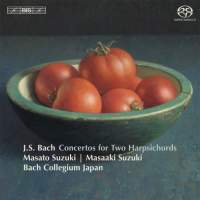Texte paru dans: / Appeared in:
*

GRAMOPHONE (08/2014)
Pour s'abonner /
Subscription information
BIS
BISSA2051

Code-barres / Barcode : 7318599920511
(ID450)
Consultez toutes les évaluations recensées pour ce cd
~~~~ Reach all the evaluations located for this CD
Reviewer: Jonathan Freeman‑Attwood
The two-keyboard idiom only occasionally catches our attention but when it does it’s always original and telling, be it Bach, Mozart or Bartók. Here, Masaaki Suzuki and his son, Masato, remind us of the special merits of a Bach sub-genre: the three concertos for two harpsichords from Leipzig, or more specifically from the years after 1729 when the composer directed the meetings of the Collegium Musicum.
All four pieces are transcriptions of a kind, the two C minors (BWV1060 and 1062) dropping a tone from their original earlier contexts as the ‘great double’ (two violins) and the ‘violin and oboe’ concertos. Choosing how to build a canvas for these refashioned pieces can take you from the pioneering Leonhardt readings, which introduced one-to-a-part chamber scorings, to the thrusting modern chamber-orchestra versions from the likes of George Malcolm and Karl Richter. Masaaki imagines these works very much as chamber creations but presented with a warm resonance which will suit almost all constituencies. The danger with the famous ‘double’ (BWV1062) is that the visceral dialoguing of the two violins can only be part-replicated on two harpsichords. Nevertheless, the association of these scores with Bach’s specific redeployment for domestic concert purposes (and, like Suzuki, obvious music for Bach to perform with a son and/or student) creates a sense of touching intimacy; both Masaaki and Masato rejoice in the simple elegance and devotional belonging which these pieces afford.
Although the orchestral accompaniment is curiously demarcated from the solos in the C major Concerto, BWV1061 (like Mozart’s K448, this is really a twokeyboard work, pure and simple), and therefore largely fulfils a harnessing role in the reworked version, the string parts elsewhere deserve rather more personality than the somewhat generic performances here, especially in BWV1060.
No such
fears trouble the ear in the fresh and beautifully judged playing of the Suzukis
throughout. Masato Suzuki’s arrangement of the Orchestral Suite in C major for
two harpsichords is matched by the liveliness of knowing exchanges, luminous
textures and an organic ‘galanterie’.
Cliquez l'un ou l'autre
bouton pour découvrir bien d'autres critiques de CD
Click either button for many other reviews


